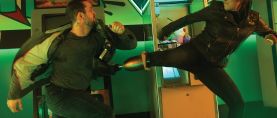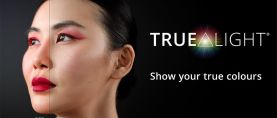
Sundance 2018 Panel: “DP First: Women Who Shoot”
This panel — held at the Canon Creative Studio in Park City on Main Street — tackled issues of gender, opportunity and commitment.

This panel — held at the Canon Creative Studio in Park City on Main Street — tackled issues of gender, opportunity and commitment.
The loudest applause at the Sundance awards ceremony was not for any contestant, but for jury member Rachel Morrison, ASC, who days earlier made history by becoming the first female cinematographer to get an Oscar nomination. That it happened now is a reflection of changing times. But the fact that it took the Academy 91 years speaks volumes about the roadblocks — and worse — that women in the film industry face.
So the discussion event “DP First: Women Who Shoot” — held on January 19 at the Canon Creative Studio — was a timely choice to kick off a series of panels hosted by Canon and moderated by American Cinematographer at the recent Sundance Film Festival. Just eight months earlier, I moderated a similar panel for the ASC in New York, and the subject of sex and power didn’t even come up.
Now, it’s inescapable.
Three cinematographers at different stages in their career gamely tackled this thorny subject during our hour-long discussion in the packed Canon Creative Studio. They talked about the work as well, offering insights into the festival fare they’d shot.
PANELISTS
AUTUMN EAKIN
Recent Project: Lenny, an HBO nonfiction series by Lena Dunham and Girls co-producer Jenni Konner, based on their Lenny Letter newsletter.
CLAUDIA RASCHKE
Recent Projects: RBG, a biography of Supreme Court Justice Ruth Bader Ginsberg by Betsy West and Julie Cohen, and The Price of Everything, Nathaniel Kahn’s documentary on contemporary art.
GRETA ZOZULA
Recent Project: Never Goin’ Back, a dramatic feature by Augustine Frizzell about the misadventures of two high school dropouts who escape their dreary town and head to the beach.

ON GENDER DISPARITY
Women directors are out there, as evidenced by Sundance’s stats: 42% of the films in this year’s festival were female-helmed. But industry-wide figures are disillusioning, with just 4% of top-grossing films directed by women and roughly the same employing female directors of photography.
The good news is this: Since the Harvey Weinstein story broke in October, several initiatives have been created, spearheaded by industry heavyweights. Among them: Time’s Up, which includes real money in its $16 million legal defense fund; 50/50 by 2020 which is pushing the networks, studios, talent agencies, and unions to look at representation among their board members, decision makers, and department heads; and Hollywood’s new Commission on Sexual Harassment and Advancing Equality in the Workplace, which will be chaired by Anita Hill.
Asked how they felt in light of such initiatives, panelists were cautiously optimistic. Raschke, a cinematographer since 1984, said she didn’t work with a single female feature director for the first 10 years of her career. Now the ratio is more evenly split — at least in her documentary and television work, which she estimates as having 40% and 20% female directors, respectively. “But feature films? Well, not really.” As for the future, “it’s hard to predict,” she says. “I’ve tried to support women coming up through ranks of camera assistant, or from being an electric and starting to shoot. Getting them in the door, supporting them, mentoring them. But in the end, it hasn’t really paid off, because it’s still very much the one who holds the power who will make the decision.”
Zozula, the youngest panelist, said, “My experience so far has been okay. But as the projects get bigger and bigger, that’s where it starts to get more challenging.”
“I do feel hopeful about it,” Eakin stated. “You have to put blinders on to do this job, because it’s insane if you actually look at the numbers. But I do feel there’s a shift that’s different this time, because money is involved, and that’s what always wins with producers and networks.”
EMOTIONAL INTELLIGENCE
“I’m pissed about the state of the industry,” said one woman in the audience. “It’s tough to know when to be a reformist, when to be patient, when to be an educator. I’m always changing that line I draw.”
“Over the years, I’ve learned that honing emotional intelligence is the way to go,” replied Raschke, who’d found renewed inspiration in Ruth Bader Ginsberg’s example. “She is such a petite little lady and so powerful, working with men who are very determined about the law. She found the best ways to change people’s minds. I took inspiration from her—how she works with emotional intelligence.”
Eakin picked up on the theme: “It’s about reading a room. Pick your battles,” she said. “The way to be a good collaborator is to try to learn that person.” She added, “Know your own triggers too, what you’re sensitive to.”
Raschke spoke about the tactics she uses when confronted with a passive-aggressive crew member: “I do these five questions to figure out what’s going on: I’ll ask ‘Is anything going on?’ just to test the waters. If it doesn’t go away, then I will address it and ask, ‘Did I do something to upset you?’” she said. “You crystallize the problem: Is it really your responsibility? Or can you help the person find a solution to their problem. Because so often people will project their problem onto you because you happen to be right in front of them or you happen to be the DP.”
CINEMATOGRAPHERS XX
Eakin spoke about the female cinematographers collective she founded, Cinematographers XX. “I got a little tired of people saying, ‘Oh, I really do want to hire women, I just don’t know where to find them,’” she recalled. Taking inspiration from Film Fatales, a collective for women directors started by her friend Leah Meyerhoff in 2013, Eakin took decisive action after Ellen Kuras, ASC invited a group of women DPs to her house. “She said she didn’t have much time, but did have a platform. ‘Give me something to talk about,’” Eakin recalls Kuras saying.
Today the collective’s public front is “a heavily curated website of professional female cinematographers,” with an adjunct Nu Wave section of up-and-comers. “There a lot of heavy hitters on there who didn’t necessarily need our website to help them, but they very graciously got behind us,” Eakin said. In addition to Kuras, that includes ASC members Amy Vincent, Cynthia Pushnek, Lisa Wiegand, Nancy Schreiber and Reed Morano. “We also have a crew list, but it’s still light on female technicians.”
Beyond being a resume platform, Cinematographers XX also organizes inter-guild events to give members a chance to press the flesh with producers, directors, and other potential collaborators. And they meet amongst themselves “to shoot the shit, talk about lenses, and find people who can cover you for a job,” said Eakin. As she underscored, your reputation depends in part on who you recommend and whether they do solid work.
THEIR SUNDANCE FILMS
Finally, each cinematographer was asked what aspect of their Sundance project they particularly liked — perhaps a favorite moment or shot.
Zozula singled out “the most collaborative moment” on Never Goin’ Back: a 2-1/2 minute oner that included five characters. “It was just the most fun thing to choreograph and pull off. It never changed from the moment we decided to do it,” she averred. “It stayed the same in the edit and didn’t get cut shorter. It feels good to be able to do that.”
Raschke observed that her lighting in the two documentaries was most present in the interviews. “There are different challenges whenever you walk into a location and have to just make it happen,” she noted. “I’m very happy that it has some sort of continuity that I didn’t foresee. Maybe that happened because I like broad strokes with lighting and highlights that are quite bright. It comes from my painter background.”
For Lenny’s pilot, Eakin filmed a short called “Orgasmic Meditation.” (Yes, it’s a thing. “Google it,” Eakin told the crowd.) Because women literally spread their legs and were utterly vulnerable before the camera, “I felt a responsibility to present them in a beautiful way,” Eakin stated, who was careful to choose rooms with large windows. “I’m really happy how those sessions turned out visually. It was just me in the room; my AC was on the monitor in the other room. So it was just me, moving around, trying to get the coverage that you need, but being very mindful of the space that you’re in.” She added, “It’s HBO, so you can show whatever you want [...] We showed women’s vaginas in full, but it’s not gratuitous.”
This panel discussion was live streamed via the AC Facebook page and can be seen here:
Go to our main Sundance page to find other discussions held at the Canon Creative Studio.






